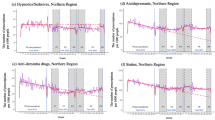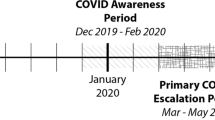Abstract
Background
Psychotropic medicine utilisation in older adults continues to be of interest because of overuse and concerns surrounding its safety and efficacy.
Objective
This study aimed to characterise the utilisation of psychotropic medicines in older people in New Zealand.
Methods
We conducted a repeated cross-sectional analysis of national dispensing data from 1 January, 2005 to 31 December, 2019. We defined utilisation using the Anatomical Therapeutic Chemical classification defined daily dose system. Utilisation was measured in terms of the defined daily dose (DDD) per 1000 older people per day (TOPD).
Results
Overall, the utilisation of psychotropic medicines increased marginally by 0.42% between 2005 and 2019. The utilisation increased for antidepressants (72.42 to 75.21 DDD/TOPD) and antipsychotics (6.06–19.04 DDD/TOPD). In contrast, the utilisation of hypnotics and sedatives (53.74–38.90 DDD/TOPD) and anxiolytics decreased (10.20–9.87 DDD/TOPD). The utilisation of atypical antipsychotics increased (4.06–18.72 DDD/TOPD), with the highest percentage change in DDD/TOPD contributed by olanzapine (520.6 %). In comparison, utilisation of typical antipsychotics was relatively stable (2.00–2.06 DDD/TOPD). The utilisation of venlafaxine increased remarkably by 5.7 times between 2005 and 2019. The utilisation of zopiclone was far greater than that of other hypnotics in 2019.
Conclusions
There was only a marginal increase in psychotropic medicines utilisation from 2005 to 2019 in older adults in New Zealand. There was a five-fold increase in the utilisation of antipsychotic medicines. Continued monitoring of psychotropic medicine utilisation will be of interest to understand the utilisation of antidepressants and antipsychotic medicines during the coronavirus disease 2019 pandemic year.







Similar content being viewed by others
References
Bednarczyk E, Cook S, Brauer R, Garfield S. Stakeholders’ views on the use of psychotropic medication in older people: a systematic review. Age Ageing. 2022;51(3):afac060. https://doi.org/10.1093/ageing/afac060.
Bobo WV, Grossardt BR, Lapid MI, Leung JG, Stoppel C, Takahashi PY, et al. Frequency and predictors of the potential overprescribing of antidepressants in elderly residents of a geographically defined U.S. population. Pharmacol Res Perspect. 2019;7(1):e00461. https://doi.org/10.1002/prp2.461.
Cullen B, Smith DJ, Deary IJ, Pell JP, Keyes KM, Evans JJ. Understanding cognitive impairment in mood disorders: mediation analyses in the UK Biobank cohort. Br J Psychiatry. 2019;215(5):683–90. https://doi.org/10.1192/bjp.2019.188.
Wojt IR, Cairns R, Clough AJ, Tan ECK. The prevalence and characteristics of psychotropic-related hospitalisations in older people: a systematic review and meta-analysis. J Am Med Dir Assoc. 2021;22(6):1206-14.e5. https://doi.org/10.1016/j.jamda.2020.12.035.
Gerhard T, Huybrechts K, Olfson M, Schneeweiss S, Bobo WV, Doraiswamy PM, et al. Comparative mortality risks of antipsychotic medications in community-dwelling older adults. Br J Psychiatry. 2014;205(1):44–51. https://doi.org/10.1192/bjp.bp.112.122499.
Bernardo M, Rico-Villademoros F, García-Rizo C, Rojo R, Gómez-Huelgas R. Real-world data on the adverse metabolic effects of second-generation antipsychotics and their potential determinants in adult patients: a systematic review of population-based studies. Adv Ther. 2021;38(5):2491–512. https://doi.org/10.1007/s12325-021-01689-8.
WHO Collaborating Centre for Drug Statistics Methodology. Guidelines for ATC classification and DDD assignment. https://www.whocc.no/atc_ddd_methodology/purpose_of_the_atc_ddd_system/. Accessed 14 Mar 2022.
López-Álvarez J, Sevilla-Llewellyn-Jones J, Agüera-Ortiz L. Anticholinergic drugs in geriatric psychopharmacology. Front Neurosci. 2019;13:1309. https://doi.org/10.3389/fnins.2019.01309.
Gerretsen P, Pollock BG. Drugs with anticholinergic properties: a current perspective on use and safety. Expert Opin Drug Saf. 2011;10(5):751–65. https://doi.org/10.1517/14740338.2011.579899.
Dilks S, Xavier RM, Kelly C, Johnson J. Implications of antipsychotic use: antipsychotic-induced movement disorders, with a focus on tardive dyskinesia. Nurs Clin N Am. 2019;54(4):595–608. https://doi.org/10.1016/j.cnur.2019.08.004.
Zádori D, Veres G, Szalárdy L, Klivényi P, Vécsei L. Drug-induced movement disorders. Expert Opin Drug Saf. 2015;14(6):877–90. https://doi.org/10.1517/14740338.2015.1032244.
Baldwin DS, Aitchison K, Bateson A, Curran HV, Davies S, Leonard B, et al. Benzodiazepines: risks and benefits: a reconsideration. J Psychopharmacol. 2013;27(11):967–71. https://doi.org/10.1177/0269881113503509.
Airagnes G, Pelissolo A, Lavallée M, Flament M, Limosin F. Benzodiazepine misuse in the elderly: risk factors, consequences, and management. Curr Psychiatry Rep. 2016;18(10):89. https://doi.org/10.1007/s11920-016-0727-9.
Hirano Y, Ii Y. Changes in prescription of psychotropic drugs after introduction of polypharmacy reduction policy in Japan based on a large-scale claims database. Clin Drug Investig. 2019;39(11):1077–92. https://doi.org/10.1007/s40261-019-00838-w.
Jackson JW, Fulchino L, Rogers J, Mogun H, Polinski J, Henderson DC, et al. Impact of drug-reimbursement policies on prescribing: a case-study of a newly marketed long-acting injectable antipsychotic among relapsed schizophrenia patients. Pharmacoepidemiol Drug Saf. 2018;27(1):95–104. https://doi.org/10.1002/pds.4354.
Kjosavik SR, Gillam MH, Roughead EE. Average duration of treatment with antidepressants among concession card holders in Australia. Aust N Z J Psychiatry. 2016;50(12):1180–5. https://doi.org/10.1177/0004867415621392.
Leopold C, Zhang F, Mantel-Teeuwisse AK, Vogler S, Valkova S, Ross-Degnan D, et al. Impact of pharmaceutical policy interventions on utilisation of antipsychotic medicines in Finland and Portugal in times of economic recession: interrupted time series analyses. Int J Equity Health. 2014;13:53. https://doi.org/10.1186/1475-9276-13-53.
Pharmaceutical Management Agency (PHARMAC). Online pharmaceutical schedule: March 2022. https://schedule.pharmac.govt.nz/ScheduleOnline.php. Accessed 14 Mar 2022.
Royal Australian and New Zealand College of Psychiatrists. The use of antipsychotics in residential aged care: clinical recommendations developed by the RANZCP Faculty of Psychiatry of Old Age (New Zealand). https://www.ranzcp.org/files/resources/college_statements/practice_guidelines/. Accessed 14 Mar 2022.
Højlund M, Andersen JH, Andersen K, Correll CU, Hallas J. Use of antipsychotics in Denmark 1997–2018: a nation-wide drug utilisation study with focus on off-label use and associated diagnoses. Epidemiol Psychiatr Sci. 2021;30: e28. https://doi.org/10.1017/s2045796021000159.
Damiani G, Federico B, Silvestrini G, Bianchi CB, Anselmi A, Iodice L, et al. Impact of regional copayment policy on selective serotonin reuptake inhibitor (SSRI) consumption and expenditure in Italy. Eur J Clin Pharmacol. 2013;69(4):957–63. https://doi.org/10.1007/s00228-012-1422-3.
Georgi U, Tesch F, Schmitt J, de With K. Impact of safety warnings for fluoroquinolones on prescribing behaviour: results of a cohort study with outpatient routine data. Infection. 2021;49(3):447–55. https://doi.org/10.1007/s15010-020-01549-7.
Ndukwe HC, Tordoff JM, Wang T, Nishtala PS. Psychotropic medicine utilisation in older people in New Zealand from 2005 to 2013. Drugs Aging. 2014;31(10):755–68. https://doi.org/10.1007/s40266-014-0205-1.
Tucker M, Hosford I. Use of psychotropic medicines in residential care facilities for older people in Hawke’s Bay, New Zealand. N Z Med J. 2008;121(1274):18–25.
Roberts E, Norris P. Regional variation in anti-depressant dispensings in New Zealand: 1993–1997. N Z Med J. 2001;114(1125):27–30.
Ndukwe HC, Wang T, Tordoff JM, Croucher MJ, Nishtala PS. Geographic variation in psychotropic drug utilisation among older people in New Zealand. Australas J Ageing. 2016;35(4):242–8. https://doi.org/10.1111/ajag.12298.
Ministry of Health. Pharmaceutical collection (2017). Publicly funded pharmaceutical dispensings between 1 January 2005 and 31 December 2016. Extraction date: 1 November 2017.
Ministry of Health. Pharmaceutical collection (2020). Publicly funded pharmaceutical dispensings between 1 July 2012 and 31 December 2019 for a selected cohort. Extraction date: 10 March 2020.
Merlo J, Wessling A, Melander A. Comparison of dose standard units for drug utilisation studies. Eur J Clin Pharmacol. 1996;50(1–2):27–30. https://doi.org/10.1007/s002280050064.
Statistics New Zealand. National population estimates: at 30 June 2021. https://www.stats.govt.nz/tools/stats-infoshare. Accessed 15 Mar 2022.
Xu J, Hao Q, Qian R, Mu X, Dai M, Wu Y, et al. Optimal dose of serotonin reuptake inhibitors for obsessive-compulsive disorder in adults: a systematic review and dose-response meta-analysis. Front Psychiatry. 2021;12: 717999. https://doi.org/10.3389/fpsyt.2021.717999.
Bighelli I, Trespidi C, Castellazzi M, Cipriani A, Furukawa TA, Girlanda F, et al. Antidepressants and benzodiazepines for panic disorder in adults. Cochrane Database Syst Rev. 2016;9(9):CD011567. https://doi.org/10.1002/14651858.CD011567.pub2.
Patetsos E, Horjales-Araujo E. Treating chronic pain with SSRIs: what do we know? Pain Res Manag. 2016;2016:2020915. https://doi.org/10.1155/2016/2020915.
Crocco EA, Jaramillo S, Cruz-Ortiz C, Camfield K. Pharmacological management of anxiety disorders in the elderly. Curr Treat Options Psychiatry. 2017;4(1):33–46. https://doi.org/10.1007/s40501-017-0102-4.
Alexopoulos GS. Pharmacotherapy for late-life depression. J Clin Psychiatry. 2011;72(1): e04. https://doi.org/10.4088/JCP.7085tx2cj.
Cipriani A, Furukawa TA, Salanti G, Geddes JR, Higgins JP, Churchill R, et al. Comparative efficacy and acceptability of 12 new-generation antidepressants: a multiple-treatments meta-analysis. Lancet. 2009;373(9665):746–58. https://doi.org/10.1016/s0140-6736(09)60046-5.
Behlke LM, Lenze EJ, Pham V, Miller JP, Smith TW, Saade Y, et al. The effect of venlafaxine on electrocardiogram intervals during treatment for depression in older adults. J Clin Psychopharmacol. 2020;40(6):553–9. https://doi.org/10.1097/jcp.0000000000001287.
Scherf-Clavel M, Hommers L, Wurst C, Stonawski S, Deckert J, Domschke K, et al. Higher venlafaxine serum concentrations necessary for clinical improvement? Time to re-evaluate the therapeutic reference range of venlafaxine. J Psychopharmacol. 2020;34(10):1105–11. https://doi.org/10.1177/0269881120936509.
Michelsen JW, Meyer JM. Cardiovascular effects of antipsychotics. Expert Rev Neurother. 2007;7(7):829–39. https://doi.org/10.1586/14737175.7.7.829.
Newcomer JW. Second-generation (atypical) antipsychotics and metabolic effects: a comprehensive literature review. CNS Drugs. 2005;19(Suppl. 1):1–93. https://doi.org/10.2165/00023210-200519001-00001.
Jauhar S, Guloksuz S, Andlauer O, Lydall G, Marques JG, Mendonca L, et al. Choice of antipsychotic treatment by European psychiatry trainees: are decisions based on evidence? BMC Psychiatry. 2012;12:27. https://doi.org/10.1186/1471-244x-12-27.
McKean A, Vella-Brincat J. Regional variation in antipsychotic and antidepressant dispensing in New Zealand. Australas Psychiatry. 2010;18(5):467. https://doi.org/10.3109/10398562.2010.502573.
Stargardt T, Edel MA, Ebert A, Busse R, Juckel G, Gericke CA. Effectiveness and cost of atypical versus typical antipsychotic treatment in a nationwide cohort of patients with schizophrenia in Germany. J Clin Psychopharmacol. 2012;32(5):602–7. https://doi.org/10.1097/JCP.0b013e318268ddc0.
Trifirò G, Spina E, Gambassi G. Use of antipsychotics in elderly patients with dementia: do atypical and conventional agents have a similar safety profile? Pharmacol Res. 2009;59(1):1–12. https://doi.org/10.1016/j.phrs.2008.09.017.
Hálfdánarson Ó, Zoëga H, Aagaard L, Bernardo M, Brandt L, Fusté AC, et al. International trends in antipsychotic use: a study in 16 countries, 2005–2014. Eur Neuropsychopharmacol. 2017;27(10):1064–76. https://doi.org/10.1016/j.euroneuro.2017.07.001.
Carton L, Cottencin O, Lapeyre-Mestre M, Geoffroy PA, Favre J, Simon N, et al. Off-label prescribing of antipsychotics in adults, children and elderly individuals: a systematic review of recent prescription trends. Curr Pharm Des. 2015;21(23):3280–97. https://doi.org/10.2174/1381612821666150619092903.
Bachmann CJ, Aagaard L, Bernardo M, Brandt L, Cartabia M, Clavenna A, et al. International trends in clozapine use: a study in 17 countries. Acta Psychiatr Scand. 2017;136(1):37–51. https://doi.org/10.1111/acps.12742.
Alexopoulos GS, Streim J, Carpenter D, Docherty JP. Using antipsychotic agents in older patients. J Clin Psychiatry. 2004;65(Suppl. 2):5–99 (discussion 100–2; quiz 3–4).
Juergens S. Alprazolam and diazepam: addiction potential. J Subst Abuse Treat. 1991;8(1–2):43–51. https://doi.org/10.1016/0740-5472(91)90026-7.
Pharmaceutical Management Agency (PHARMAC). Available from: https://pharmac.govt.nz/assets/schedule-dispatch-2016-12.pdf. Accessed 14 Mar 2022.
Clay E, Falissard B, Moore N, Toumi M. Contribution of prolonged-release melatonin and anti-benzodiazepine campaigns to the reduction of benzodiazepine and Z-drugs consumption in nine European countries. Eur J Clin Pharmacol. 2013;69(4):1–10. https://doi.org/10.1007/s00228-012-1424-1.
Gunja N. In the Zzz zone: the effects of Z-drugs on human performance and driving. J Med Toxicol. 2013;9(2):163–71. https://doi.org/10.1007/s13181-013-0294-y.
Nishtala PS, Chyou TY. Zopiclone use and risk of fractures in older people: population-based study. J Am Med Dir Assoc. 2017;18(4):368.e1-8. https://doi.org/10.1016/j.jamda.2016.12.085.
Ancoli-Israel S. Sleep and its disorders in aging populations. Sleep Med. 2009;10(Suppl. 1):S7-11. https://doi.org/10.1016/j.sleep.2009.07.004.
Bjorvatn B, Meland E, Flo E, Mildestvedt T. High prevalence of insomnia and hypnotic use in patients visiting their general practitioner. Fam Pract. 2017;34(1):20–4. https://doi.org/10.1093/fampra/cmw107.
Louzada LL, Machado FV, Nóbrega OT, Camargos EF. Zopiclone to treat insomnia in older adults: a systematic review. Eur Neuropsychopharmacol. 2021;50:75–92. https://doi.org/10.1016/j.euroneuro.2021.04.013.
Acknowledgements
The authors thank the Analytical Services, Ministry of Health of New Zealand, for supplying the data extracted from the Pharms database.
Author information
Authors and Affiliations
Corresponding author
Ethics declarations
Funding
No funding was provided for the publication of this article.
Conflicts of interest/Competing interests
Prasad S. Nishtala and Te-yuan Chyou have no conflicts of interest that are directly relevant to the content of this article.
Ethics approval
This study was approved by the Human Ethics Committee of the University of Bath, UK (form number 7423).
Consent to participate
Not applicable.
Consent for publication
Not applicable.
Availability of data and material
The data are owned by the Analytical Services, Ministry of Health NZ, and hence we cannot share raw data for this study.
Code availability
Not applicable.
Authors’ contributions
Study concept and design: PSN; statistical analysis: PSN, TC; interpretation of data: PSN, TC; drafting of the manuscript: PSN; critical revision of the manuscript for important intellectual content: PSN, TC; study supervision: PSN. PSN and TC have read and approved the final submitted manuscript and agree to be accountable for the work.
Rights and permissions
About this article
Cite this article
Nishtala, P.S., Chyou, Ty. An Updated Analysis of Psychotropic Medicine Utilisation in Older People in New Zealand from 2005 to 2019. Drugs Aging 39, 657–669 (2022). https://doi.org/10.1007/s40266-022-00965-8
Accepted:
Published:
Issue Date:
DOI: https://doi.org/10.1007/s40266-022-00965-8




